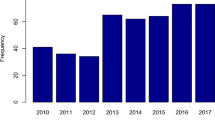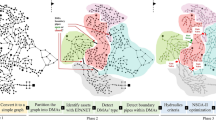Abstract
The major purpose of this paper is to present the useful techniques in the optimal allocation of water resources (OAWR) and to demonstrate using water resources applications how these methods can be conveniently employed in practice for systematically studying both simple and complex water resources problems. Formal modelling techniques in multiobjective decision-making provide many benefits to professionals working in water resources and elsewhere. A new Large-system Hierarchical Dynamic Programming (LHDP) method to solve the model can be carried out to ascertain the consequences of meaningful parameter changes upon the optimal or compromise solution.
As a case study, the techniques and methods are applied to the OAWR of the Yellow River Basin (YRB) of China. The next paper shares with the reader recent research results on the OAWRYRB.
Similar content being viewed by others
Abbreviations
- L i :
-
inflows from the trunk stream in the subregioni.
- S i :
-
run-off volume of the river sectioni.
- Q i :
-
net inflows of intervals in the subregioni.
- W i :
-
volumes of water drawn the trunk stream ofi into subdistricti.
- H i :
-
volumes of water returning to the trunk stream in the subdistricti.
- B i(W i):
-
the maximum net benefits (in hundred million yuan) from the annual-water consumption ofW iin subregioni.
- W ik :
-
the annual-water consumption (in hundred million m3) of sectorK in subregioni, k = 1, 2, 3, 4.
- B ik(W ik :
-
the maximum net benefits (in hundred million yuan) from the annual consumptionW ikof sectork in subregioni.
- BS i(S i):
-
the maximum net benefits (in hundred million yuan) obtained from the optimal allocation of the run-off volumeS iof river trunki among different sectors within the months of a year.
References
Menenti, M., Chamboule, J., Morabito, J., Fornero, K., and Stefanini, L.: 1992, Appraisal and optimization of agricultural water use in large irrigation schemes: I. Theory,Water Resour. Manag. 6(63), 185–199.
Menenti, M., Chamboule, J., Morabito, J., Fornero L., and Stefanini, L.: 1992, Appraisal and optimization of agricultural water use in large irrigation schemes: II. Applications,Water Resour. Manage. 6(3), 201–221.
Tang Desshan: 1990, Research on the optimal operation manner of hydropower stations with dual attention to demands of hydropower generation and navigation,J. Hohai Univ. 18(5), Nanjing, China.
Tan Deshan and Zhuo Zhihao: 1990, An attempted method of calculating navigation benefits from the trunk stream of the Yellow River,J. Hohai Univ., Nanjing, China.
Floyd, R. L. and Jackson, M. C.: 1991,Creative problem solving: Total systems Intervention, John Wiley, Chichester, U.K.
Tan Deshan: 1990, Research on the coordination algorithms for optimal allocation of water resources in River Basin,J. Hohai Univ. 19(1), Nanjing, China.
Author information
Authors and Affiliations
Rights and permissions
About this article
Cite this article
Tang, D. Optimal allocation of water resources in large river basins: I. Theory. Water Resour Manage 9, 39–51 (1995). https://doi.org/10.1007/BF00877388
Received:
Accepted:
Issue Date:
DOI: https://doi.org/10.1007/BF00877388




